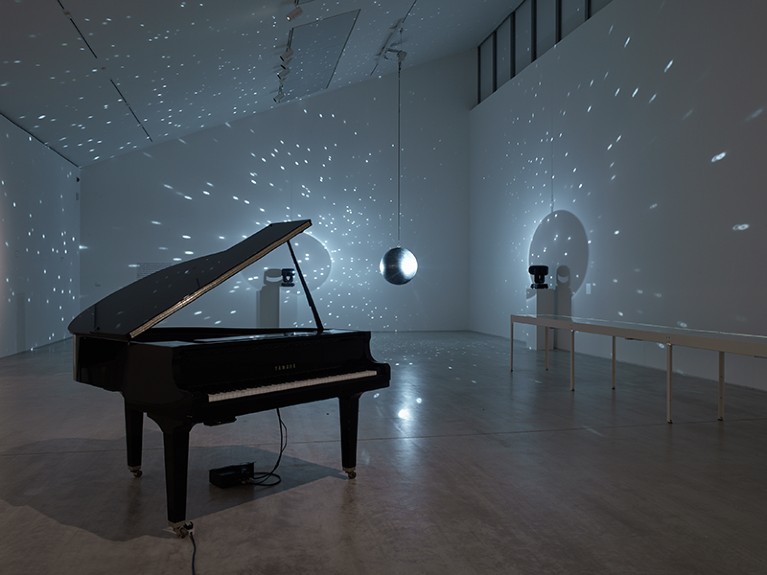
An installation from Katie Paterson’s exhibition A Place That Exists Only in Moonlight.Credit: Stephen White
A Place That Exists Only in Moonlight Turner Contemporary, Margate, UK. Until 6 May.
Many of your works play with temporal and spatial immensities. All the Dead Stars (2009) is an etching on black anodized aluminium of the locations of the 27,000 or so known stars that have reached the end of their life cycle. Do you also look to the future?
Yes. For the ongoing Dying Star Letters (2011–), I write letters of condolence for stars recorded as ‘dead’. History of Darkness (2010–) is an ongoing archive of slides of dark areas of the Universe seen through various telescopes. Over the next century, a trust set up for Future Library (2014–2114) will commission 100 writers, so far including Margaret Atwood and David Mitchell, to write a story that will remain sealed until 2114. The stories will then be printed on paper crafted from trees planted in a Norwegian forest.
Some of your works speak to concerns about the environment. The 2007–08 Vatnajökull relayed the sound of meltwater flowing in an Icelandic glacier to listeners by mobile phone.
The phone call to the glacier was a one-to-one experience: listening to a graveyard of ice. The crisis of global warming doesn’t feel intimate through screens and graphs — yet, of course, it is. Our planet is disappearing. Humans understand the cycle of birth and dying. We need a contemporary approach to what Stephen Hawking called ‘cathedral thinking’: far-reaching vision that is humanly relatable.
You have said, “Time runs through everything I make.” How so?
I find professions that routinely deal with long timescales fascinating. For the foresters participating in Future Library, 100 years is normal. Geologists work across time periods in which major extinctions become plots on a map. Astronomers work with spans of time beyond everything that has ever lived. For me, the route to a different kind of understanding of time is through the imagination. My art attempts to deal directly with concepts I can’t get to otherwise. My journey in astronomy has been a search for connection: understanding that we are not separate from the Universe, but are intrinsically linked.
Some of your projects connecting us to deep space and time seem also almost to address the futility of trying to track it all.
History of Darkness has futility written into it, capturing infinite darkness from across space and time. Learning that these images refer to places beyond human life could expand our relationship to these phenomena, and enhance our sense of fallibility. I’m drawn to the idea of the Universe as deep wilderness. There is a ‘cosmic horizon’ billions of parsecs away, and what lies beyond it will forever remain outside our understanding. Creating artwork is as much my own way of grappling with the ‘divine incommensurability’ of our position in the Universe as it is an attempt to communicate it to others.

Katie Paterson working on Future Library (2014–2114).Credit: Giorgia Polizzi
In 2007’s Earth-Moon-Earth (Moonlight Sonata Reflected from the Surface of the Moon), you beamed Ludwig van Beethoven’s work in Morse code to the Moon in radio waves, and reconstructed the partial score reflected back. How do such events happen?
That artwork was created with ‘Moon bouncers’: groups of people who send radio messages to each other by way of the Moon. I simply wrote to them. While at the Slade School of Fine Art at University College London, I wandered into the Rock & Ice Physics Laboratory next door. They let me play my glacial-ice records in their walk-in freezers. That was when I found out how easy it was to approach others in different fields. All the Dead Stars involved hundreds of researchers. Some shared data, others developed the artworks with me. Scientists working on a NASA mission proposal have invited me to join them as a ‘space-artist/co-investigator’ enquiring into cosmic dust. I’m extremely happy that these scientists feel an artist might have something of value to contribute to their research.
The Cosmic Spectrum (2019) is a rotating colour wheel, with segments showing the “average colours” of the Universe from the Big Bang to now, using data from the 2dF Galaxy Redshift Survey. How do you stay abreast of scientific advances?
I discovered astronomer Ivan Baldry’s work on the cosmic spectrum several years ago. Many of my ideas sit on the back burner for years. Sometimes, one experience has enough potency to carry projects through years later. I’m drawn to current investigations into the sunsets on Mars caught by NASA’s Curiosity rover. And just looking at titles in science libraries can evoke compelling images.
Your 2019 book A Place that Exists Only in Moonlight catalogues ideas that sound almost like research proposals: “The speed of light slowed to absolute stillness”, say.
It contains artworks that exist in the mind, many of which refer to cosmic matter. The cover is printed with Moon dust, dust from Mars, ancient meteorites and asteroids. I wanted the reader to be able to hold and touch the material the words describe, while taking them in. The ideas are like thought experiments, Zen koans. In a way, that’s true of all my art. What time is it on Venus? What texts will be read by unborn people? Is it possible to plant a forest using saplings from the oldest tree on Earth? I’m always curious.

 World of webs
World of webs
 The artist as astronaut
The artist as astronaut
 The space poet
The space poet







